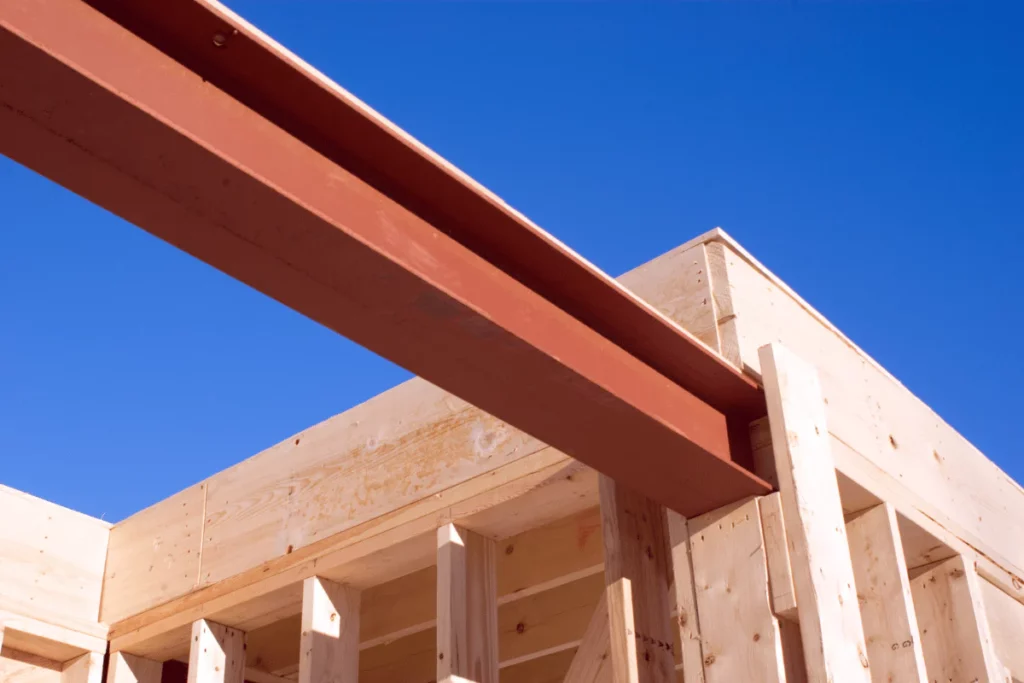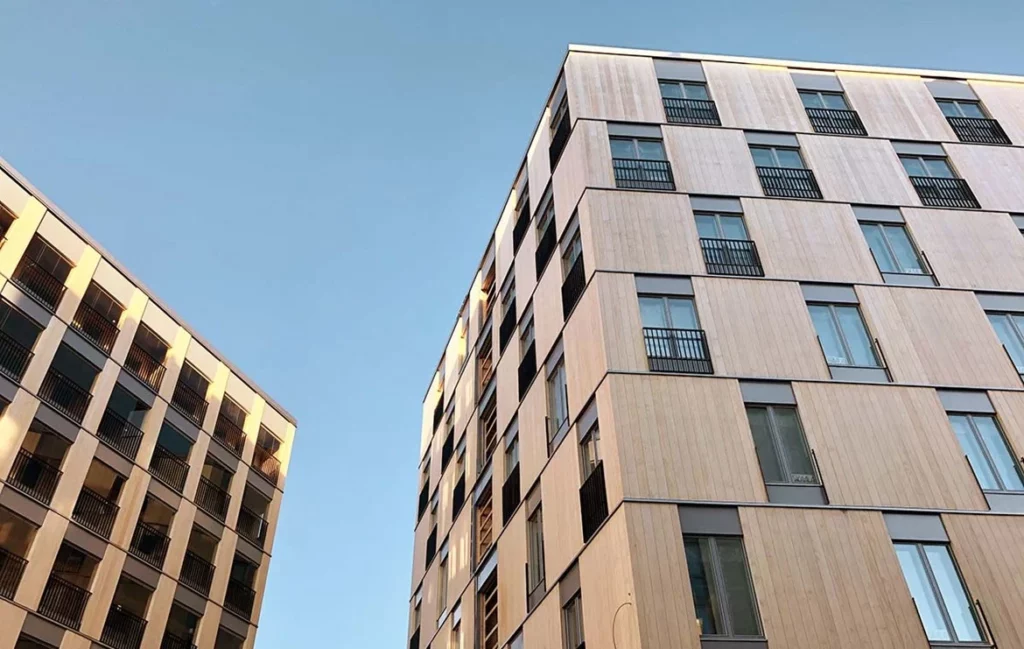Laminated Veneer Lumber (LVL) beams are a significant advancement in modern construction technology. These engineered wood products are made by bonding multiple layers of thin wood veneers together using high pressure and heat, resulting in strong and stable structural elements.
The use of LVL beams in today’s building projects has transformed construction practices by offering:
- Improved Strength: LVL beams can support heavier loads compared to traditional timber.
- Resistance to Warping: Unlike regular wood, LVL beams are less likely to warp, twist, or shrink over time.
- Design Versatility: LVL beams can span longer distances without the need for additional supports, allowing for more open and flexible designs.
- Cost Savings: The installation of LVL beams can be quicker and more cost-effective, reducing both labour and material expenses.
In addition to their performance benefits, LVL beams also align with the increasing demand for environmentally friendly construction materials. These engineered components make efficient use of timber resources by:
- Transforming small trees into strong structural elements.
- Minimising waste through streamlined manufacturing processes.
- Consuming less energy during production compared to steel or concrete alternatives.
LVL beams have found applications in various sectors of construction, including residential and commercial projects. Their adaptability makes them suitable for:
- Supporting walls with headers and beams.
- Constructing floors and roofs.
- Building structures using post and beam techniques.
- Providing structural support in multi-storey buildings.
The growing popularity of LVL beams represents a shift towards sustainable, efficient, and innovative solutions in construction that meet contemporary building needs while prioritising environmental responsibility.

Importance of LVL Beams in Modern Construction
LVL beams are essential structural elements in today’s building projects. They provide excellent load-bearing capacity and design flexibility, making them ideal for various applications. These engineered wood products meet different architectural needs through their:
1. Structural Adaptability
- Support for long-span applications
- High strength-to-weight ratio
- Custom sizing options for specific project needs
The use of LVL beams in sustainable construction practices offers significant benefits:
2. Resource Optimisation
- Reduced material waste during manufacturing
- Efficient use of timber resources
- Lower carbon footprint compared to steel alternatives
Key Selection Criteria for LVL Beams:
- Load Requirements
- Dead load calculations
- Live load considerations
- Span specifications
- Environmental Conditions
- Moisture exposure levels
- Temperature variations
- Chemical exposure risks
- Project Specifications
- Building code compliance
- Fire resistance ratings
- Acoustic performance needs
The structural capabilities of LVL beams go beyond traditional timber limitations, allowing architects and engineers to develop innovative building solutions. These engineered components support modern architectural trends while ensuring strong structural integrity and meeting strict building standards.
Structural Applications of LVL Beams
LVL beams serve multiple structural functions in modern construction projects, adapting to diverse architectural requirements. These engineered wood products excel in critical load-bearing applications:
Primary Support Structures
- Roof and floor beams spanning large distances
- Headers above windows and doors
- Load-bearing columns in multi-storey buildings
- Rim boards for enhanced structural stability
The load-bearing capacity of LVL beams varies based on their specific application:
- Beams: Support loads up to 2,900 pounds per linear foot
- Headers: Withstand point loads of 3,500 pounds
- Columns: Bear vertical loads exceeding 40,000 pounds
- Rim Boards: Resist lateral forces up to 400 pounds per linear foot
LVL beams demonstrate exceptional performance in:
- Long-span applications requiring minimal support
- Multi-residential projects with open floor plans
- Commercial buildings demanding high load resistance
- Industrial structures requiring robust structural elements
The dimensional stability of LVL beams allows for precise engineering calculations, enabling architects to design spaces with exact specifications. These beams maintain their shape under varying loads, making them ideal for projects requiring consistent performance throughout their lifecycle. Read more about lifecycle at https://www.elifecycle.org/
The strength-to-weight ratio of LVL beams permits lighter construction while maintaining structural integrity, reducing foundation requirements and installation costs. This characteristic proves particularly valuable in renovation projects where weight considerations are crucial.

Advantages of Using LVL Beams
LVL beams have significant advantages over traditional lumber in modern construction projects. These beams are engineered, which makes them stronger and lighter than regular timber, with strength ratios that can be up to 50% better.
Benefits of the Manufacturing Process
The way LVL beams are made brings several benefits:
1. Superior Dimensional Stability
- Minimal warping and twisting
- Consistent moisture content
- Reduced shrinkage and swelling
2. Enhanced Structural Performance
- Greater load-bearing capacity
- Uniform strength throughout
- Predictable engineering values
Architectural Possibilities with LVL Beams
LVL beams enable architects to create expansive, open-plan spaces through their extended spanning capabilities. These beams can span distances up to 20 metres without intermediate support, transforming architectural possibilities in both residential and commercial projects.
The precision engineering of LVL beams allows for:
- Wider column-free spaces
- Higher ceilings
- Flexible floor plan configurations
- Reduced material waste during installation
Streamlining Construction with LVL Beams
The dimensional accuracy of LVL beams streamlines the construction process. Pre-cut lengths and consistent dimensions eliminate the need for extensive on-site modifications, reducing labour costs and construction timelines. This precision also ensures seamless integration with other building components, creating efficient and reliable structural systems.
For a deeper understanding of the different timber typologies including LVL, you can refer to this comprehensive guide on timber typologies.
Environmental Benefits of LVL Beams
LVL beams represent a significant advancement in sustainable construction practices through their innovative manufacturing process and efficient use of natural resources. The production of LVL beams maximises timber yield by utilising small-diameter trees that might otherwise be unsuitable for traditional lumber applications.
Resource Efficiency
- Utilises up to 90% of the log compared to 60% in traditional lumber
- Incorporates fast-growing, sustainable tree species
- Reduces waste through precise manufacturing processes
Green Building Certification
- Contributes to LEED certification points
- Meets sustainable building standards
- Supports carbon sequestration goals
The manufacturing process of LVL beams aligns with green building practices by reducing wood waste and optimising forest resources. Small-diameter trees, which traditionally held limited commercial value, become valuable construction materials through LVL production. This approach supports sustainable forestry management and reduces pressure on old-growth forests.
Carbon Benefits
- Stores carbon throughout the building’s lifecycle
- Requires less energy to produce than steel or concrete
- Creates minimal manufacturing waste
The use of engineered wood products like LVL beams in construction projects demonstrates a commitment to environmental stewardship. These materials support responsible forest management practices while delivering high-performance building solutions. The ability to create strong structural elements from smaller trees showcases the potential for sustainable innovation in construction materials.
Factors to Consider When Selecting LVL Beams
Choosing the right LVL beams involves careful consideration of various technical and practical factors. This ensures optimal performance and safety in construction projects.
1. Load Requirements
Understanding the loads that the LVL beams will support is crucial. Consider the following load factors:
- Dead loads from permanent structural elements
- Live loads from occupancy and usage
- Dynamic loads from wind or seismic activity
- Point loads from specific equipment or fixtures
2. Span Length Specifications
The span length of the beams plays a significant role in their design and performance. Take into account the following span length specifications:
- Maximum clear span requirements
- Deflection limits under various load conditions
- Support conditions and bearing requirements
- Beam depth restrictions based on architectural design
3. Compliance and Standards
Ensuring compliance with relevant building codes and standards is essential for the safety and legality of your construction project. Pay attention to the following compliance and standards:
- Australian Building Codes and Standards
- Local council regulations
- Engineering certification requirements
- Fire resistance ratings
4. Environmental Considerations
The environment in which the LVL beams will be installed can impact their performance and durability. Consider the following environmental factors:
- Exposure to moisture or weather conditions
- Temperature fluctuations
- Chemical exposure in industrial settings
- UV radiation exposure
5. Installation Parameters
Understanding the installation process and any limitations is crucial for successful beam placement. Take into account the following installation parameters:
- Access limitations during construction
- Connection details and hardware requirements
- Integration with existing structural elements
- Support conditions and bearing requirements
The selection process should include consultation with structural engineers to ensure the chosen LVL beam specifications align with project requirements and safety standards. Documentation of load calculations, span tables, and compliance certificates serves as essential reference material throughout the construction process.
Maintenance Requirements for LVL Beams
LVL beams are more durable than traditional timber and require minimal maintenance throughout their lifespan. The engineered manufacturing process creates a strong material that is resistant to common wood-related problems:
Moisture Resistance
- Specialised adhesives prevent delamination
- Enhanced stability in varying humidity conditions
- Reduced susceptibility to rot and fungal growth
Pest Protection
- Chemical treatments integrated during manufacturing
- Natural resistance to termites and wood-boring insects
- Elimination of regular pest control treatments
Structural Stability
- Minimal warping or twisting under load
- No need for periodic adjustments or replacements
- Consistent performance in diverse climate conditions
The engineered nature of LVL beams eliminates many maintenance tasks associated with traditional timber:
- No requirement for regular surface treatments
- Reduced inspection frequency
- Lower lifetime maintenance costs
- Extended service life without performance degradation
These maintenance advantages make LVL beams particularly suitable for areas with limited access or where ongoing maintenance activities would disrupt building operations.
Conclusion
LVL beams are a fundamental part of modern construction, providing exceptional strength and design versatility. These engineered wood products offer outstanding strength-to-weight ratios, dimensional stability, and resistance to common wood problems. They are used in various applications, including residential and commercial buildings, where they efficiently support open floor plans and large spaces.
The production of LVL beams is environmentally friendly as it uses small-diameter trees and reduces waste. This makes them an eco-friendly choice for construction projects. Additionally, their proven durability, low maintenance needs, and cost-effectiveness make them a versatile choice for builders and architects who prioritise sustainable construction practices.
The use of LVL beams represents a significant improvement in construction technology, combining structural performance with environmental responsibility. This is crucial for the future of sustainable building practices
0 Comments